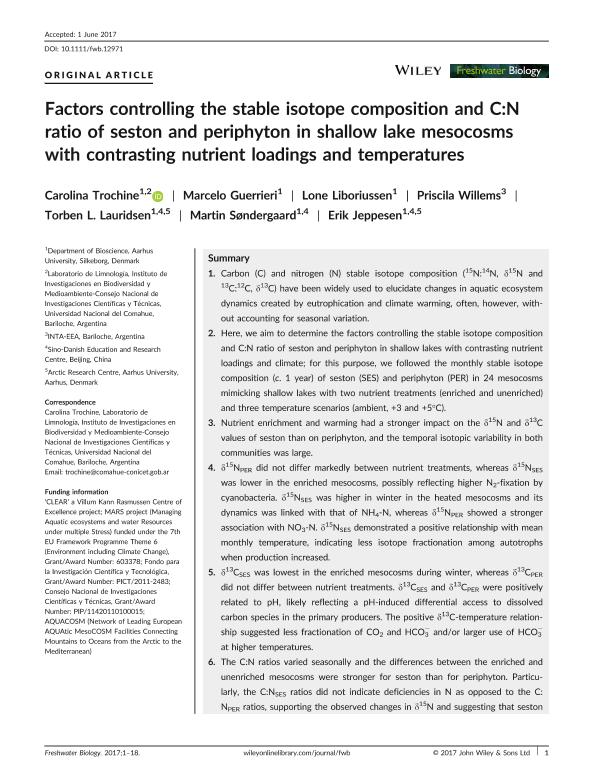Artículo
Factors controlling the stable isotope composition and C:N ratio of seston and periphyton in shallow lake mesocosms with contrasting nutrient loadings and temperatures
Trochine, Carolina ; Guerrieri, Marcelo; Liboriussen, Lone; Willems, Priscila; Lauridsen, Torben L.; Søndergaard, Martín; Jeppesen, Erik
; Guerrieri, Marcelo; Liboriussen, Lone; Willems, Priscila; Lauridsen, Torben L.; Søndergaard, Martín; Jeppesen, Erik
 ; Guerrieri, Marcelo; Liboriussen, Lone; Willems, Priscila; Lauridsen, Torben L.; Søndergaard, Martín; Jeppesen, Erik
; Guerrieri, Marcelo; Liboriussen, Lone; Willems, Priscila; Lauridsen, Torben L.; Søndergaard, Martín; Jeppesen, Erik
Fecha de publicación:
09/2017
Editorial:
Wiley Blackwell Publishing, Inc
Revista:
Freshwater Biology (print)
ISSN:
0046-5070
Idioma:
Inglés
Tipo de recurso:
Artículo publicado
Clasificación temática:
Resumen
Carbon (C) and nitrogen (N) stable isotope composition (15N:14N, δ15N and 13C:12C, δ13C) have been widely used to elucidate changes in aquatic ecosystem dynamics created by eutrophication and climate warming, often, however, without accounting for seasonal variation. Here, we aim to determine the factors controlling the stable isotope composition and C:N ratio of seston and periphyton in shallow lakes with contrasting nutrient loadings and climate; for this purpose, we followed the monthly stable isotope composition (c. 1 year) of seston (SES) and periphyton (PER) in 24 mesocosms mimicking shallow lakes with two nutrient treatments (enriched and unenriched) and three temperature scenarios (ambient, +3 and +5°C). Nutrient enrichment and warming had a stronger impact on the δ15N and δ13C values of seston than on periphyton, and the temporal isotopic variability in both communities was large. δ15NPER did not differ markedly between nutrient treatments, whereas δ15NSES was lower in the enriched mesocosms, possibly reflecting higher N2-fixation by cyanobacteria. δ15NSES was higher in winter in the heated mesocosms and its dynamics was linked with that of NH4-N, whereas δ15NPER showed a stronger association with NO3-N. δ15NSES demonstrated a positive relationship with mean monthly temperature, indicating less isotope fractionation among autotrophs when production increased. δ13CSES was lowest in the enriched mesocosms during winter, whereas δ13CPER did not differ between nutrient treatments. δ13CSES and δ13CPER were positively related to pH, likely reflecting a pH-induced differential access to dissolved carbon species in the primary producers. The positive δ13C-temperature relationship suggested less fractionation of CO2 and HCO3 − and/or larger use of HCO3 − at higher temperatures. The C:N ratios varied seasonally and the differences between the enriched and unenriched mesocosms were stronger for seston than for periphyton. Particularly, the C:NSES ratios did not indicate deficiencies in N as opposed to the C:NPER ratios, supporting the observed changes in δ15N and suggesting that seston and periphyton have access to different sources of nutrients. We did not observe any clear effect of temperature warming on the C:N ratios. Our study provides evidence of strong seasonality in the isotopic composition and C:N ratios of seston and periphyton across nutrient and temperature levels; also, we identified several factors that are likely to modulate the strength and variability in stable isotopes values and stoichiometry of sestonic and periphytic communities under these scenarios.
Archivos asociados
Licencia
Identificadores
Colecciones
Articulos(INIBIOMA)
Articulos de INST. DE INVEST.EN BIODIVERSIDAD Y MEDIOAMBIENTE
Articulos de INST. DE INVEST.EN BIODIVERSIDAD Y MEDIOAMBIENTE
Citación
Trochine, Carolina; Guerrieri, Marcelo; Liboriussen, Lone; Willems, Priscila; Lauridsen, Torben L.; et al.; Factors controlling the stable isotope composition and C:N ratio of seston and periphyton in shallow lake mesocosms with contrasting nutrient loadings and temperatures; Wiley Blackwell Publishing, Inc; Freshwater Biology (print); 62; 9; 9-2017; 1596-1613
Compartir
Altmétricas



